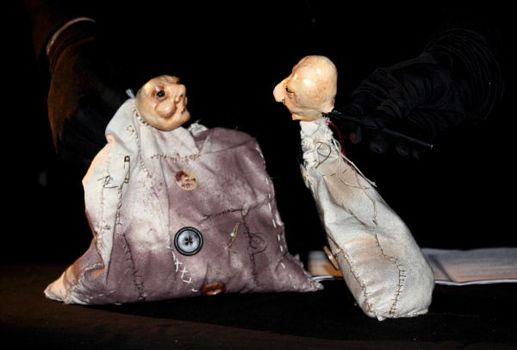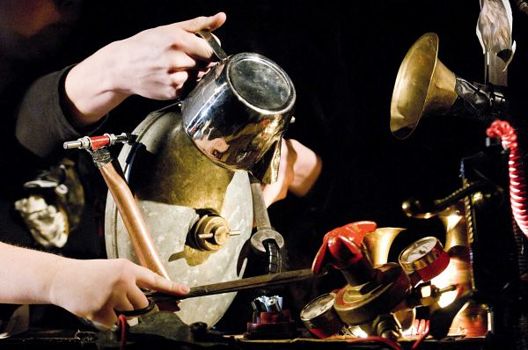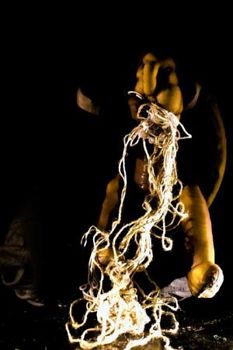Puppenspiel als interdisziplinäre Praktik
If we are to discuss puppetry as interdisciplinary practice, it is important to note that it has only recently been considered as an actual discipline, which is possible to be studied and explored in its own right within educational circles. This is not to say that techniques and processes did not exist, rather that they were not shared and taught outside the environments where it was practised. To categorise something as a ‘discipline’ both limits and frees it: it is limiting in that any categorisation implies boundaries; it is liberating because it allows the practitioners to closely consider what it means to do that practice, and to develop a language which marks its particularities. I think that it has partly become fashionable to consider puppetry as interdisciplinary, as it enables it to be recognised as a useful, flexible and creative mode of expression when in combination with other forms (not only in performance, but also in science, medicine, politics and other discourses). It is certainly true, however, that puppetry is used widely in interdisciplinary contexts and I will discuss a few of these in this short article.
Puppet theatre, of course, is a wide and varied practice, and there are as many forms of it as there are in, say, literature, physics or cooking: Joan Baixas, a Catalan puppeteer, in the introduction to the book Escenes de L’Imaginari cites, among other manifestations, animatronics, bunraku, cartoon, toy, ritual object, processional figure, cyborgs, monsters and giants as elements of puppetry (Baixas: Escenes de l’Imaginari, Barcelona: Institut del Teatre, 15). In all areas of performance and practice, puppetry intersects with other forms.
Puppetry within live theatre
Over the last twenty years, puppetry has become a distinct and popular element within live theatre. Theatre directors have recognised the power of puppetry to express ‘otherness’, ritual figures, children, animals and universal characters or concepts, and increasingly, performers are expected to develop skills in puppetry manipulation and performance in order to be able to move between acting and puppetry. In the UK, an important precedent was set when the Lecoq-trained company Complicite used a puppet for the child in The Caucasian Chalk Circle, employing a puppetry director to train and develop the work. The company has since used puppetry and animated objects in several performances, to extend the creative potential of the performers. The biggest impact was made on UK theatre history and perception by the advent of the National Theatre/Handspring Puppet Theatre’s collaboration for War Horse, in which colossal puppet horses dominate the stage. This performance, which now has versions performing in several locations across the world, has meant that a whole generation of theatregoers have seen puppets in ‘serious’ mainstage theatre. The ‘interdisciplinariness’ of the puppetry is in its sensitive collaboration with live acting. Puppetry here is an equal partner to the actors; one of many different performing possibilities.
Puppetry within Opera
Both stylised and symbolic art forms, puppetry and opera have a long history of collaboration. Puppet ‘operas’ have been in existence for over two hundred years. Again, in the UK, there has been increased interest in recent years with opera directors recognising the power of the puppet to represent aspects of narrative beyond single character. Significant collaborations have included English National Opera’s experimental and exciting performances of Madam Butterfly with the puppet company Blind Summit; Complicite’s work on Bulgakov’s A Dog’s Heart and the collaboration between puppet company Improbable Theatre and ENO on Satyagraha, based on Gandhi. A symposium on puppetry and opera was set up in 2012 by the Puppet Centre Trust and the Centre for Research into Objects and Puppets in Performance which led to new work being created between trainee opera singers and trainee puppeteers. Both parties found that the collaborations were exciting extensions of their work and that puppetry could be used to expand the comic, surreal, epic and narrative content of the pieces due to the facility of the puppeteers to explore the animation of materials to create landscapes, and the potential for the figures to perform disembodied parts of the human anatomy, such as feet (as in The Empress’s Feet).
Puppetry and Science/Medicine
In 2012, the Centre for Research into Objects and Puppets in Performance worked with the Wellcome Trust on a series of study days exploring the relationship between puppetry and science, including concepts of balance, movement and the senses. The use of an artificial body to explore anatomical concepts and principles of human biology has been particularly exciting, as the puppet can be made to represent any shape or form required; in addition to this, as noted in Kleist’s essay ‘On the Art of the Marionette’, puppetry embodies principles of physical existence that humans can only aspire to. Puppetry is increasingly used in medical contexts to explore aspects of illness, disability and care. The company Little Cauliflower has recently created a show which shows the decline of a person with Motor Neurone Disease; in 2011, the University of Warwick commissioned a puppet show which explored end of life care in medical institutions. Puppetry is used in therapy with children as it is a safe medium for them to express themselves; in hospital wards with stroke sufferers, as a means to show emotion where they are unable to speak; in health and sex education settings across the world – it is much easier for a puppet to perform embarrassing or sensitive topics than for a human to do the same – and with people suffering from dementia.
These are just a few of the areas where puppetry could be considered to be working in an ‘interdisciplinary’ way. Puppetry, by nature, is interdisciplinary from the outset, as it includes design, making, performance, vocal expression, awareness of movement, and performance. It is a unique and diverse art form which has impact across the world and in multiple settings.
Cariad Astles forscht und lehrt am Centre for Research into Objects and Puppets in Performance an der Royal Central School of Speech and Drama in London (CSSD). Die CSSD bietet mit einem Puppetry BA die einzige Hochschulausbildung für Puppentheater in England. Der Studiengang ist auch für internationale Interessenten offen. Er bietet Studenten eine dreijährige Ausbildungzeit, in der sie ihre Fähigkeiten auf den Gebieten bildnerisches Gestalten, Animation, Bewegung, Stimme, Ensemblespiel, Performance u.a. entwickeln können. Das Research Centre der CSSD bringt wissenschaftliche und praktische Forschungen zum Puppen- und Objekttheater zusammen.
Information on the CSSD and Research Centre: www.cssd.ac.uk



